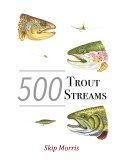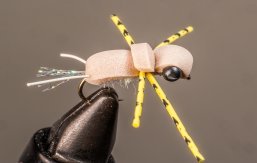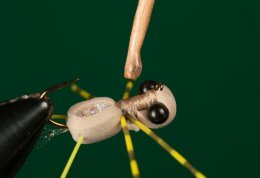The Turck Tarantula
Part 1: Origins
In part one of the Turck Tarantula, master fly tier Skip Morris takes you through the origins and development of this popular attractor fly.
In part two, he shows you how to tie it, with clear step-by-step instructions.
The Turck Tarantula: Unusual...or Not?
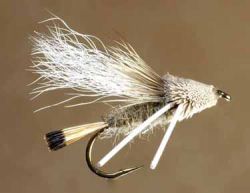 The Turck Tarantula
The Turck Tarantula
(designed by Guy Turck, tied by Skip Morris)
If this fly(often referred to as Turks Tarantula) strikes you as bizarre...well, you need to get out more.
When you do get out, take a look at the Chernobyl Ant, the Royal Coachman Trude, even my own Predator—this fly looks pretty normal
alongside other attractor dry flies.
The Irresistable Pull of the Attractor Fly
Bizarre or not, it works.
I first tried it on a small river with a healthy population of cutthroat trout. The fish were wild, strong, of good size—some truly large—and moody.
Their mood called for big attractor dry flies, it seemed, and they came freely to the Turck Tarantula.
My wife Carol and I used the fly often during our week on that and other cutthroat streams in the area, usually with success.
A Pure Attractor
In my experience—and according to everything I've read about it—the Turck Tarantula is an attractor, pure and simple.
I suppose an open-minded trout might take it for a big stonefly or even a grasshopper now and then, but the resemblance strikes me as pretty thin.
Personally, I treat it as a fly for trout
that are showing little interest in the things they normally eat,
fish that have had enough mayfly nymphs
lately
but stir at the sight of some big silly wad of hair and rubber on a hook.
Guy Turck's Tarantula:
Developing a Winner
I found this amazing fly in Jack Dennis's Tying Flies with Jack Dennis and Friends, but had heard of it before that, and what I heard was that it was a hot new attractor pattern.
According to Jack's book, Jackson Hole fishing guide Guy Turck developed the fly based on what he liked about the Madam X and what he felt it lacked.
He liked its gangly rubber-strand legs, but felt the fly lacked sufficient buoyancy. So he kept the legs; dubbed on a thick, fuzzy body, and added a head of flared buoyant deer hair.
Apparently his creation was a hit—and a winner—at the Jackson Hole One Fly contest.
How to Fish the Tarantula
for Striking Results
Jack's Tying Flies quotes Turck himself regarding how to best fish his big attractor fly:
In big fast water I just drift the fly and let the movement of the water wiggle the legs.
At the end of the drift, if nothing happens, I swing the fly in the current, pull it under and pump and retrieve it back wet.
I myself normally fish this big fly entirely on top, dead drift usually, but occasionally with twitches.
Turck's approach, however, certainly covers more ground than mine—he makes it a free-drifting dry fly, briefly a skating one, and finally a sort of
bucktail or minnow-imitation, all from one cast.
The Art of Tying the Turck Tarantula
A few tips on tying the Turck's Tarantula:
- 1. The body should be full—feel free to spin lots of dubbing onto your thread, and to wind the dubbing-covered thread up and down the shank two,
even three times.
- 2. The dubbing itself is hare's mask, if you stick with the pattern, but I prefer tan or light-brown synthetic dubbing—Poly dubbing, Antron...—because
synthetic fibers are more buoyant than fur.
- 3. If you mount the legs as I describe in the photos and captions, they'll tend to sweep back, especially if you create a tightly packed head.
If you want the legs out more to the sides, bind them on about two thirds up the body, short of the wing-head area.
Building a Spun Deer-Hair Head
Building the head is standard hair-flaring procedure—if you don't know how to flare deer hair, lots of tying books and videos out there can help.
Basically, this is how I do it:
- 1. I work a bunch of hair down around the shank; wrap two turns of heavy thread around the bunch; hold the bunch firmly in place as I
tighten the thread; draw back all the hair-ends in front, and then pull the thread firmly forward and secure it in a few tight wraps.
- 2. I bind second, perhaps even a third, bunch in front of the first in this manner, pushing each bunch back into the last.
- 3. I whip finish the thread at the eye, trim the thread, and then shape the head with scissors or a razor blade. (Handle razor blades with
great care!)
- 4. However you trim the head, make sure you hold the legs back out of the way—there is no way to replace the legs if you cut them off.
The Right Hook?
It Depends a Bit on Personal Preference
Tying Flies calls for a heavy wire hook for this large fly, insurance, perhaps, against losing the big fish it can attract. But since it is a dry fly,
I use a standard-wire or light-wire hook. I don't believe such a hook has lost me any fish yet, and this particular fly has taken me a few dandies.
I also generally use a 2X-long hook rather than the 3X long listed in Jack's book.
For photos and instructions on tying this popular attractor dry fly, go to Turck Tarantula, Part 2, Tying Steps.
Click here to hear Skip's interviews on popular podcasts...
*Announcements*
Skip has an essay in Big Sky Journal's annual Fly Fishing issue, called "Montana Hoppers: the Princess and the Brute" released February 1, 2023. Skip rewrote it a bit; I painted and illustrated it here, on our website. Here's the link on our web page to check it out:
Click here to read Skip's essay Montana Hoppers: The Princess and the Brute...
Skip's latest books:
Top 12 Dry Flies for Trout Streams: How, When, and Where to Fish Them, is now available on Amazon as an ebook...check it out! Click on the links below to go to the information page on Top 12 Dry Flies (the link to Amazon is at the bottom of the page...)
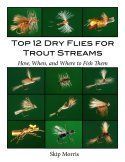 Top 12 Dry Flies for Trout Streams: How, When, and Where to Fish Them
Top 12 Dry Flies for Trout Streams: How, When, and Where to Fish Them
Click here to get more information about
Top 12 Dry Flies for Trout Streams: How, When, and Where to Fish Them (the link to Amazon is at the bottom of the page)...
Top 12 Dry Flies for Trout Streams: How, When, and Where to Fish Them (the link to Amazon is at the bottom of the page)...
Top 12 Nymphs for Trout Streams: How, When, and Where to Fish Them, 2nd Edition, originally published as an e-book only, is now available on Amazon as a paperback...check it out! Click on the links below to go to the information page on Top 12 Nymphs (the link to Amazon is at the bottom of the page...)
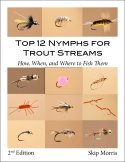 Top 12 Nymphs for Trout Streams: How, When, and Where to Fish Them (2nd Edition)
Top 12 Nymphs for Trout Streams: How, When, and Where to Fish Them (2nd Edition)
Click here to get more information about
Top 12 Nymphs for Trout Streams: How, When, and Where to Fish Them (2nd Edition). . .
Top 12 Nymphs for Trout Streams: How, When, and Where to Fish Them (2nd Edition). . .
Click here to get more information about Skip's e-book,
500 Trout Streams...
500 Trout Streams...
Skip's latest paperback book:
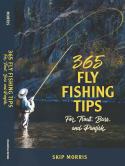 365 Fly Fishing Tips for Trout, Bass, and Panfish
365 Fly Fishing Tips for Trout, Bass, and Panfish
Click here to get more information about Skip's latest book,
365 Tips for Trout, Bass, and Panfish...
365 Tips for Trout, Bass, and Panfish...
Print Skip's chart for FREE:
Skip Morris's Trout-Fly Proportion Chart
Go to Skip Morris's Trout Fly Proportion Chart
Skip's Predator is available to buy...
Skip's ultra-popular Predator—a hit fly for bluegills and other panfishes and largemouth bass (also catches smallmouth bass and trout)—is being tied commercially by the Solitude Fly Company.
The Predator
CLICK HERE to learn more about or to purchase the Predator...
Learn to Tie Skip's Predator
Do you want to tie the Predator?
Tying the Predator
Skip shows you how to tie it on his YouTube Channel link, listed below:
CLICK HERE to see Skip's detailed video on how to tie the Predator...






